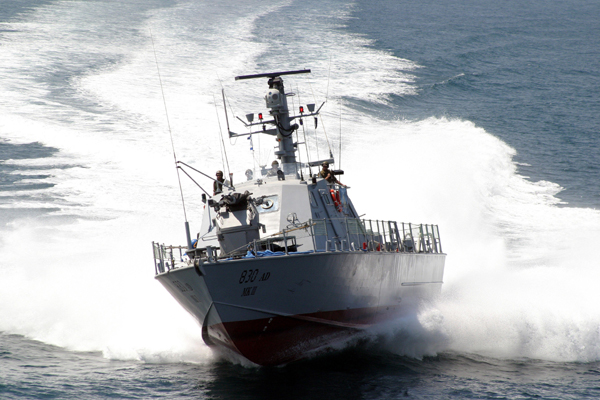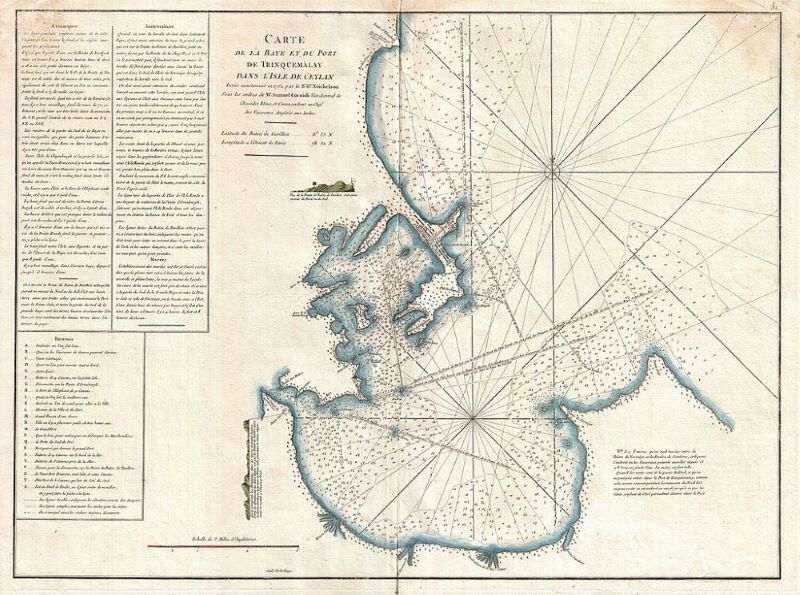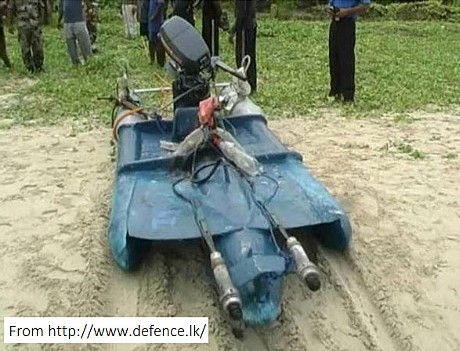The Sri Lankan Liberation Tigers of Tamil Eelam (LTTE) naval arm, the Sea Tigers were one of the most competent and feared maritime adversaries in modern times. Operating small vessels and suicide craft in support of the LTTE’s goal of an independent Tamil state in Sri Lanka, the Sea Tigers dominated the northeastern coastline of the island and sought to imperil the maritime lifeline between the Sri Lankan Navy (SLN) base in the east at Trincomalee, and the besieged army units stationed at Jaffna in the north.
Formed in the 1980’s during the early stage of the insurgency against the Sri Lankan government, the Trincomalee Fast Attack Flotilla formed the main littoral strike force of the Sri Lankan Navy for two decades of sustained combat. They suffered during the 1990’s onslaught by the the Sea Tigers, but with improved tactics, leadership and weaponry, the Flotilla finished the war in 2009 helping to substantially destroy their adversaries and significantly contributed to overall Sri Lankan victory.
Their numerous coastal engagements in squadrons of heavily-gunned high-speed attack boats recall the battles of an earlier era; those of MTB’s versus E-boats in the English Channel during WW2. As in the Channel, many of the Flotilla’s engagements were confused affairs in darkness; fast craft racing into the attack, formations clashing, cannon pounding, tracers arcing out, the thump of incoming hits, crippled vessels sinking, shaken survivors limping home aboard battle-damaged boats.
Initially tasked with interdicting LTTE seaborne supplies crossing from nearby India over the narrow Palk Strait, in the 1980’s the Flotilla had an easy time, policing smugglers and trawlers. The speed and firepower of their early Fast Attack Craft (FAC) were rarely challenged. But the success of the Flotilla’s early interdiction operations led to a dramatic evolution of the Sea Tigers, who themselves began to use squadrons of fast shallow-draft small boats packed with machine guns, and to seek out the SLN gunboats as targets.
During its long war, the Flotilla operated detachments at Jaffna, Mannar and Colombo, but its main base was always the superb harbour of Trincomalee (Trinco). Used successively by the Portuguese, Dutch, British and French, Trinco harbour dominates the eastern Indian Ocean, and accommodated many of the Flotilla’s mix of fast gunboats. Most famous of these were the Israeli-built Dvora platforms, the first two of which were delivered in 1984. With additional Super Dvora’s, the comparable Shaldag’s and the locally built Colombo class, the SLN ultimately fielded 45 of these outwardly similar FAC’s, losing 20 in action during the war.
All these aluminium-hulled planing craft had one thing in common; incredible speed. The Dvora’s and the Shaldag’s were capable of over 45 knots, and the latest of the Colombo’s top 53 knots, staking a claim as the fastest FAC’s in the region.
As well as high speed, the reefs and sandbars that abound around the Sri Lankan coastline necessitated shallow draught. The generic Dvora’s use twin 4600 hp diesels to run either two Arneson articulating surface drives, mounted on the transom, rather than under the hull, or twin Kamewa water jets, which keep their draft to around one meter. At 60 tons and 25m in length they could range 700 nautical miles and carried a crew of a dozen men.
The early Dvora’s sported a belt-fed 20mm canon and a couple of light machine guns, but this armament was soon outgunned by newer Sea Tiger boats. A typical Sea Tiger fibreglass Muraj vessel was armed with single or twin 23mm canon, four 0.50 calibre machine guns as well as RPG’s, carried a crew of up to 14 and was capable of 45 knots. Supported by smaller craft, they often operated in packs, and their tactics and firepower began to take a toll on the SLN.
In response, the Flotilla’s FAC’s were upgunned. One SLN Dvora damaged in an engagement in 2006 and stripped by the Sea Tigers yielded a 23mm canon system, four 0.50 calibre HMG’s, 5 LMG’s and a 40mm Automatic Grenade Launcher.
As the tactics, firepower and sophistication of the LTTE improved in the 1990’s and the operational area widened, the Flotilla was tasked with much broader responsibilities. To their original anti-smuggling role was added convoy escort, harbour defence, Special Forces transport, land attack and sea control missions. The extra tasks, combined with the increased aggressiveness of the Sea Tigers, dramatically increased the number of engagements, and also the Flotilla’s losses.
In August 1993 a new Sea Tiger technique, the high-speed explosives-laden low-profile suicide boat, claimed the first Dvora to be sunk, off Point Pedro. This landmark, on the northern tip of the island, lay near the heart of the island’s Tamil lands and along the convoy route between Trinco and the naval harbour at Jaffna.
Jaffna, in the heart of Tamil Sri Lanka, was retaken by the Sri Lankan Army (SLA) in December 1995, but as it was surrounded by LTTE forces, resupply and troop rotation was only possible via a maritime convoy system from Trinco (the western coast being too shallow for larger vessels). With the LTTE controlling most of the coastline between Jaffna and Trinco, and the Sea Tigers based throughout the lagoons and inlets of this area, this stretch of sea became a graveyard for the small ships and men on both sides.
Two Dvora’s came under combined sea and land attack in August 1995 off Mullaitivu; LTTE artillery and a captured tank fired on them, sinking both. One went down in a sea battle in 1996 and another succumbed to a suicide boat in 1997.
This suicide attack would be a template for future Sea Tiger interdiction of the Jaffna convoys. Typically, a group of armed speedboats and suicide craft would, under cover of darkness and often using clusters of fishing craft as cover, attack a convoy miles off the coast. The SLN FAC would race to intercept, closing with the foe at a combined 80 knots. The Sea Tigers would try to direct their gunfire at the Dvora’s sterns, to knock out the engines and immobilise them. Amid their barrage, tiny speedboats packed with explosives would race in, looking to ram. Several Dvora’s were lost in this manner, sometimes with all hands. See this Al Jazeera clip for combat footage of such an encounter.
The convoys kept coming; so did the Sea Tigers. In February 1998 20 Sea Tiger boats took on a squadron of 8 Dvora’s in a five-hour night battle near Point Pedro. Five Sea Tiger craft were sunk and about 30 crew killed, but they managed to disable and capture one Dvora, stripping and later sinking it. A similar battle the next year went better for the Flotilla; 4 Dvora’s sinking 4 Sea Tiger boats for only minor injuries, but all the boats suffered gunfire damage.
In 2000, peace broke out on the battlefields and at sea, as international observers arrived, and the Flotilla was able to lick its wounds. More vessels came on strength, but the Sea Tigers too used the opportunity to build up their arsenal. They built more fibreglass attack craft, imported new twin 23mm cannons and advanced radar for their fleet, and trained new sailors.
The Boxing Day tsunami of 2004 caused havoc on both sides. The navy lost a Shanghai class gunboat, but the Sea Tiger bases were also badly hit, with many of their small craft destroyed. Hostilities erupted again fully in 2006. The Flotilla suffered heavy losses this year; two FAC sunk by suicide boats and four more to gunfire in vicious battles north of Trinco.
A convoy escorting a troopship to Jaffna was intercepted in May 2006 by the Sea Tigers with heavy losses on both sides. Worse still, LTTE ground forces closed in on the Trinco naval base, and brought it under long range artillery fire. This was the crucial moment in the whole campaign, in the whole war. If Trinco had been neutralised as the FAC Flotilla base, resupply to Jaffna would not have been possible, the northern ground front would have collapsed, and the Tigers would have had their independent state. This was the tipping point, only visible in hindsight, and from here the Sea Tigers went downhill. They still fought with remarkable ferocity and skill, but gradually the SLN got the upper hand.
In September the Sri Lankan Army retook the rebel positions around Trinco and removed the threat to the base, but several hard-fought small craft battles flared around the harbour itself, the Flotilla getting the better of their opponents, but always with losses and damage.
The FAC Flotilla still had many battles to fight. But a new Navy fleet was now at sea to share their burden. The light Arrow boats, modelled on a captured Sea Tiger craft were coming on line in strength. At 14 or 17 metres in length, they were powered by multiple 200hp outboards and mounted several machine guns and grenade launchers. They operated in swarms, like the Tiger boats, and were crewed by the elite SLN equivalent of the British SBS.
They formed the inshore line of an intimidating triad, with the Flotilla FAC’s further to seaward and the new, larger Offshore Patrol Vessels (OPV’s) further out again, intercepting the LTTE supply ships, often at strategic distances. Together, they cut off the LTTE from their sophisticated international supply chain, depriving them of new arms and equipment. At the same time, a four division multi-pronged Sri Lankan Army offensive gradually reduced the LTTE perimeter.
Improved inter-service co-operation also saw the Flotilla receive more tactical assistance from Sri Lankan Airforce Hind gunships and fighter-bombers, and along with other squadrons of the Sri Lankan Navy, they facilitated several large-scale amphibious operations for the Sri Lankan Army. Better Intelligence allowed the SLN to intercept LTTE supply ships up to 1500 km from the coast, crucially cutting the insurgents maritime supply routes.
The Flotilla’s last battles were to prevent LTTE leaders from fleeing, as the Army overran the last Sea Tiger bases. At the end of the war in May 2009, the Sea Tigers had been completely eliminated. Very few of their 3000-odd peak strength survived the war, many wasted in senseless attacks against the implacable wall of the SLN triad in the final weeks of combat. During the entire war, the SLN suffered 400 officers and men killed in action, losing half their FAC’s, a number of larger vessels, and dozens of smaller craft.
It had been a long and brutal war for the Flotilla, up against the most proficient and sophisticated insurgent navy in modern history. The vicious small craft actions, convoy escort missions, use of suicide boats, swarm tactics and high-speed night gun battles that characterised the maritime war have considerable relevance to potential conflicts in other strategic environments around the world today. The Malacca Strait, the Red Sea, the Straits of Hormuz and the South China Sea are all maritime theatres that could foreseeably experience similar contests in the future.
The Sri Lankan Navy’s effective combination of large numbers of light inshore craft supported in deeper water by fast, heavily armed gunboats is therefore quite pertinent should any of these theatres become ‘hot.’
For a closer look at some footage from small craft and operations of the Sri Lankan Navy https://www.youtube.com/watch?v=7J_1I9M7kSM.



